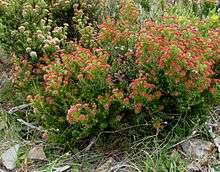Ozothamnus alpinus
| Ozothamnus alpinus | |
|---|---|
 | |
| Ozothamnus alpinus Mount Hotham, Victoria | |
| Scientific classification | |
| Kingdom: | Plantae |
| (unranked): | Angiosperms |
| (unranked): | Eudicots |
| (unranked): | Asterids |
| Order: | Asterales |
| Family: | Asteraceae |
| Tribe: | Gnaphalieae |
| Genus: | Ozothamnus |
| Species: | O. alpinus |
| Binomial name | |
| Ozothamnus alpinus (N.A.Wakef.) Anderb. [1] | |
| Synonyms | |
|
Helichrysum alpinum N.A.Wakef. | |
Ozothamnus alpinus, commonly known as alpine everlasting, is a shrub in the family Asteraceae. It is native to alpine and subalpine areas in the states of New South Wales and Victoria in Australia.[2]
It usually grows to between 0.75 and 1 metre high and has oblong leaves that are 4 to 10 mm long and 2 to 3 mm wide.[2] These have glossy green upper surfaces, while underneath they are yellowish and covered with hairs.[2]
The species was formally described in 1951 by Norman Wakefield based on a specimen collected by Carl Walter at Mount Hotham in 1888.[3] Wakefield gave it the name Helichrysum alpinum. In 1991 the species was transferred to the genus Ozothamnus.[1]
The white flowers appear in small dense heads from December to March in the species native range. The pink or red outer bracts stand out when the flowers are in bud.[4]
The species occurs from the Mount Kosciuszko area and southwards on the edge of wet alpine heath or in bogs.[2][4]
References
- 1 2 "Ozothamnus alpinus". Australian Plant Name Index (APNI), IBIS database. Centre for Plant Biodiversity Research, Australian Government, Canberra. Retrieved 30 December 2012.
- 1 2 3 4 Everett, J. "Ozothamnus alpinus (Wakef.) Anderb.". PlantNET - New South Wales Flora Online. Royal Botanic Gardens & Domain Trust, Sydney Australia. Retrieved 30 December 2012.
- ↑ "Helichrysum alpinum". Australian Plant Name Index (APNI), IBIS database. Centre for Plant Biodiversity Research, Australian Government, Canberra. Retrieved 30 December 2012.
- 1 2 Corrick, M.G. & Fuhrer, B.A. (2001). Wildflowers of Victoria and adjoining areas. Australia: Bloomings Books. p. 35. ISBN 1876473142.